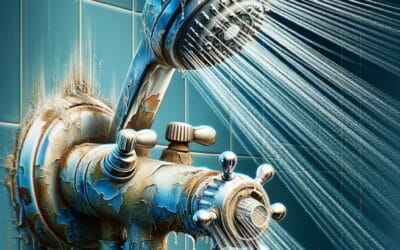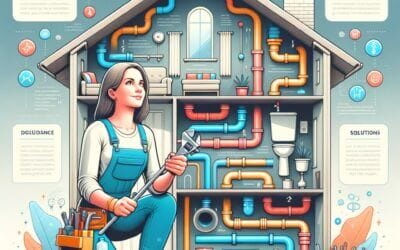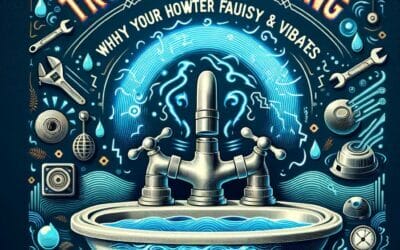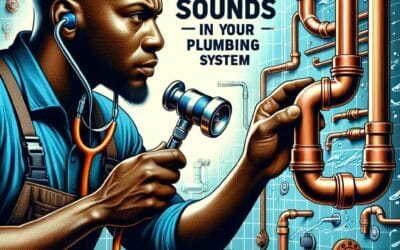Welcome to our comprehensive guide on “Addressing Low Home Water Pressure: Causes & Solutions”. Weak trickling showers and slow filling toilets are often due to low water pressure, a common issue in many homes. If you’re severely missing your powerful shower or if it takes forever to fill your bath up, this guide is here to help.
We will cover reasons behind low water pressure, how to diagnose where it emanates from, and most importantly, practical solutions to rectify this. Every home is different and as such, the causes and solutions may vary greatly. Thus, by providing a well-rounded insight into this topic, we believe you will be able to navigate and solve this issue more efficiently and effectively. Remember, understanding is key when it comes to addressing any home maintenance problem. Let’s dive in and demystify low home water pressure together!
Understanding the Concept of Home Water Pressure
When we talk about home water pressure, we are referring to the force with which water comes out of the home faucets and appliances. Typically measured in pounds per square inch (PSI), adequate water pressure is crucial for the proper functioning of your home appliances like washing machines, dishwashers, and showers. However, several homeowners often struggle with low water pressure, causing inconvenience and affecting everyday life.
There could be many reasons for low water pressure in your home, and understanding these can help you address the issue effectively. Some of the common causes include:
- Aging, corroded pipes – Over time, pipes can get worn out and narrow down due to corrosion, affecting water flow.
- Peak usage times – If your water pressure drops generally during specific times, your neighborhood might be using water all at once, impacting the pressure.
- Plumbing leaks – Leaks in the system can also lead to decreased water pressure as not all the water reaches its intended end point.
So, what exactly can you do when faced with low water pressure issues? Here’s a quick guide to some solutions you can try:
| Problem | Solution |
|---|---|
| Corroded Pipes |
Replace old pipes with new ones made of more durable materials. |
| Peak Usage Times |
Try altering your water usage schedule, such as doing laundry or showers at non-peak hours. |
| Leaks |
Inspect the system and repair any leaks found. |
Remember, each house is different and there might be other specific reasons and solutions for low water pressure in your home. When in doubt, getting a professional plumber to analyze and fix the issue can be a good idea.

Diagnosing the Issue: Common Signs Indicating Low Home Water Pressure
Experiencing low water pressure in your home can be incredibly frustrating, resulting in slow filling tubs, weak showers, and inefficient appliances. While there are many potential causes of low water pressure, there are some common signs that indicate this problem. One of the most obvious signs is a decrease in the force of your water flow. This is often most noticeable when using faucets, showers, or appliances that require a strong flow of water. You may also notice that the problem is specific to certain areas, which could suggest a localized issue.
Moreover, if you are hearing unusual noises from your pipes paired with the weaken flow of water, it can be a clue pointing towards the pressure problem. Also, the emerging of dirty water indicates impending water pressure issues. Besides, your water meter and the pressure gauge readings sometimes serve as signals. A substantial fluctuation in the readings signifies pressure inconsistencies.
| Common Signs | Possible Cause |
|---|---|
| Decreased water flow | Obstruction in pipes or water leaks |
| Problem specific to certain areas | Localized plumbing issue |
| Unusual noises from pipes | Air buildup in pipes |
| Dirty Water | Corrosion inside pipes |
| Fluctuation in water meter and pressure gauge readings | Issue in water supply |
Identifying these signs early can save your time and money. It’s essential to take right action promptly to avoid worsening of scenarios. This includes reaching out to plumbing professionals who can diagnose and address the root cause and hence, restoring your home’s water pressure to normal.

Getting Down to the Root: Likely Causes of Low Home Water Pressure
Have you ever turned your faucet on and wished the water flow was a little stronger? You’re not alone. There are several potential root causes of low home water pressure, and figuring out the culprit can require some investigation. One common reason might be old, corroded galvanized iron pipes which may eventually lead to reduced water pressure as the corrosion inside the pipes builds up, leading to a restricted water flow. Another probable cause could be a malfunctioning water pressure regulator. This device adjusts the water pressure from the municipal supply to a level safe for your home’s plumbing system. If it’s not working properly, it might lower the pressure too much.
A leak in your home’s plumbing system may also result in low water pressure. If water is seeping out somewhere in your system, it won’t make it to your faucet with its usual force. Yet another culprit could be running too many water-consuming appliances or fixtures at the same time. For instance, if someone is having a shower while the washing machine is running and another family member decides to water the garden, your water pressure may understandably drop.
| Cause | Potential Solution |
|---|---|
| Old, corroded pipes | Replace with new pipes |
| Malfunctioning water pressure regulator | Fix or replace the regulator |
| Leak in plumbing system | Identify and seal the leak |
| Running multiple water-consuming appliances or fixtures simultaneously | Try to spread out water use |
These possible causes aren’t exhaustive, but they’re a good place to start when seeking to understand why you’re facing low water pressure at home. Each problem comes with its own solutions, from replacing old pipes to balancing your home’s water usage.

When to Call the Professionals: Expert Assessment of Your Home Water Pressure
There are limits to what your DIY methods can achieve when fixing water pressure problems at home. At times, the issues are much deeper than a clogged pipe or a faulty valve and may require a professional plumber’s eye. Professionals pose superior knowledge of water systems and can more accurately pinpoint the issue, saving you time, money, and potential further damage to your home.
It’s best to call in the professionals when:
- Your DIY attempts have not improved your water pressure
- Your home is old, and the plumbing hasn’t been updated in decades
- You’re experiencing reduced water pressure throughout the entire house, not just on one fixture
- There’s evidence of a significant leak
An experienced plumber will conduct a thorough investigation of your home water system. They’ll check your city supply, main shut-off valve, pressure regulator, water meter, and individual fixtures. A thorough assessment not only identifies the issue but also assesses the general condition of your plumbing.
| Professional Service | Potential Issue | Solution |
|---|---|---|
| City Supply Check | Low supply pressure | Report to the local water supply company |
| Main Valve Inspection | Partially closed valve | Open the valve completely |
| Pressure Regulator Review | Faulty regulator | Replace pressure regulator |
| Water Meter Diagnosis | Leak in your system | Fix the leak |
Knowledge is power. Professionals provide valuable insights into the state of your water pressure and plumbing as a whole. Not only will they fix the current problem, but they can also make recommendations for preventing future issues. With professional help, your water pressure should be back to optimum levels in no time.

A Self-help Guide: Simple DIY Fixes for Low Home Water Pressure
Low pressure water in your home can really be a pain. It can make usual tasks like laundry, dishes, showering all become laborious and time-consuming activities. The good news is, there are some simple DIY troubleshooting methods and solutions that you can do to fix this issue. But before diving into the solutions, it’s important to understand the potential causes of low water pressure at home. Firstly, let’s dive into the most common causes of low water pressure. Four main culprits usually cause low pressure: faulty plumbing, issues with the shutoff valve, clogged pipes and filters, or an overloaded shared pipeline. Occasionally, the issue can also be due to the water supplier’s side, so it’s important to rule that out with your provider. Below is a table summarizing the causes and their DIY fixes.
| Cause | DIY Solution |
|---|---|
| Faulty Plumbing | Check for leaks and repair/replace pipes if necessary |
| Shutoff Valve Issues | Ensure valve is fully open |
| Clogged Pipes and Filters | Clean or replace filters, flush the system |
| Overloaded Shared Pipeline | Try to reduce water usage during peak demand hours |
Now that you know the common causes, you can begin troubleshooting at home. If you’ve eliminated all of the above causes, the issue may lie in your water pressure regulator or pressure-release valve. This is a little more complex to fix, so we recommend consulting with a professional plumber in this case to avoid causing any unintentional damage. Always remember, when dealing with water pressure issues, it’s important to work systematically. Start with simple causes first before moving onto more complex ones. With these handy tips and approaches to troubleshoot low home water pressure, you can save time and money. This guide empowers every homeowner to understand the basics of their home water system, and the potential issues that may lead to low water pressure.
Venturing into Long-term Solutions: Enhancing Home Water Pressure the Right Way
In delving into the crux of enduring solutions for low home water pressure, initially scrutinizing the piping system comes first. This issue is commonly due to aged and corroded pipes which block the free flow of water. A great deal of homeowners has been able to restore their residential water pressure simply by replacing outdated galvanized iron pipes with modern copper or PVC piping. It’s worth noting that this fix, while effective, will require the services of a skilled plumber. Nevertheless, you can check up on less complex factors like malfunctioning shut-off valves, aerator blockages, and shared pipes with neighbors experiencing similar issues. On the other hand, for homes served by municipal water supplies, the pressure regulator or reducing valve might be responsible for the low water pressure. This device, typically situated where the main line enters your abode, manages the water pressure levels. An improperly set or faulty regulator can contribute to pressure issues, making it necessary to either adjust or replace the mechanism. Additionally, your home’s elevation or the municipal supply itself can affect the water pressure. Check with your local water authority if you suspect this could be the problem.
| Problem | Solution |
|---|---|
| Outdated galvanized iron pipes | Replace with modern copper or PVC piping |
| Malfunctioning shut-off valves | Repair or replace valves |
| Faulty pressure regulator | Adjust or replace the regulator |

The Role of Regular Maintenance in Sustaining Optimal Home Water Pressure
When it comes to maintaining optimal home water pressure, routine maintenance and surveillance play pivotal roles. Failure to regularly inspect and service your water system may lead to damages and defects, and eventually a frustratingly low water pressure. Various aspects of your water system require attention from time to time. These range from the water main, which must be kept free of leaks and blockages, to pressure regulators, that needs to be checked for accurate settings, and even down to the pipes and plumbing which must be clear of lime and scale build-up. Embracing proactive maintenance has enormous benefits, some of which encompass maintaining steady flow rate, preserving pipe integrity and increasing the lifespan of your entire water system. While there are simple measures you can personally adopt like regular cleaning and de-scaling of showerheads and faucets, it is valuable to engage the services of a professional plumber or water systems engineer periodically.
| System Component | Maintenance Activity | Expected Outcome |
|---|---|---|
| Water Main | Checking for leaks and blockages | Improved water flow |
| Pressure Regulators | Adjustment for accurate settings | Consistent water pressure |
| Pipes and Plumbing | Cleaning off lime and scale build-up | Prevention of clogging and blockages |
Be sure to choose a professional trusted by many, with proven competence and experience in the field. Regular maintenance of your home water system is a small price to pay for the comfort of optimal water pressure. Don’t wait until the pressure drops, take action today for a better experience tomorrow.
The Conclusion
In conclusion, low home water pressure can be a frustrating issue. Nevertheless, understanding the root causes can help you strategize a solution more effectively. Steps that may help improve your water pressure include, but are not limited to, checking for leakages, inspecting the pressure regulator, considering the age and quality of your household plumbing, and perhaps surveying the mains water supply in your area. While some issues can be fixed with relative ease, others may require professional help. The key takeaway here is not to ignore the ‘symptoms’ of your home’s water pressure. Proactive action may save you from more significant and costly issues in the future. Remember, a well-functioning, efficient water supply system is not just convenient—it is an indispensable part of a comfortable and healthy living environment.







